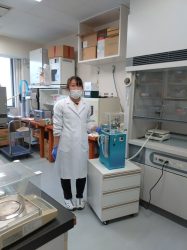The solvent evaporation time was reduced by a half for blood and urine samples!
For this review, we met with Dr. Katsuragi, who is in charge of medicolegal autopsies for the Graduate School of Medical and Dental Sciences, Niigata University.

┃Topics
- For urine samples, the concentration process was completed in half the time required for Nitrogen Blowdown Evaporator!
- Reduced variation in the concentration and less sample splashing!
- Processing of multiple samples by cleaning / replacing the Spiral Plugs 3 times per day!
┃Research contents and purpose of concentration
We perform forensic drug analysis on samples obtained during medicolegal autopsies, which are carried out on a daily routine. The Smart Evaporator is used for sample pretreatment prior to analysis.
GC-MS/MS is used for analysis of medicinal toxins . In order to detect trace levels of these compounds with high sensitivity, concentration and drying must be done. On a day when an autopsy is scheduled, it can take half a day for a single case and experimental work cannot be done. Therefore, the pretreatment processes are carried out together on a day when an autopsy is not scheduled. Because most of the samples consist of blood and urine, sample pretreatment is performed using the QuEChERS method. For dried samples, ethyl acetate is added for analysis using GC-MS/MS.
┃Conditions for using Smart Evaporators
- Model owned: Smart Evaporator MT8
- Type of containers used: polypropylene microtubes(1.5mL)
- Solvents : Acetonitrile, approx. 500µL
- Set temperature: 40℃
- Sample: Blood / urine / gastric contents
- Frequency of concentration: 1 to 2 times per week
- Working time: 20 – 30 min per operation, concentration of 8 samples at a time
- Installation site: On top of a base with casters, with the exhaust hose extended to an outlet.
┃Reason for selecting the Smart Evaporator/ Work after installation.
A teacher in the same laboratory recommended after watching the guidance of Smart Evaporator. Initially, we were interested in the Smart Evaporator C10 light, but because the Smart Evaporator MT8 can be used with microtubes, we were finally interested in this newly launched product.
Prior to receiving the Smart Evaporator, we used a Nitrogen Blowdown Evaporator with 36 holes for attaching spray nozzles for sample concentration. Basically, eight samples can be concentrated in a single operation, but for use with more samples, we tried increasing the number of nozzles. However, when the number of nozzles is increased, the N2 gas flow varied with the position of the nozzle, this resulted in a variation in concentration and of splashing the sample caused by nitrogen blowdown. We were considering how to resolve this issue.

┃Impression after using Smart Evaporator
<Advantages>
- Because the concentration and drying process is faster than before, we had a feeling that using the Smart Evaporator it would be possible to increase the number of samples that could be processed. There may not be a big difference for blood samples because of the smaller water content, but for concentration of urine samples, we found evaporation even for more than 40 – 50 min using the nitrogen blowdown method was incomplete. While with the MT-8 Smart Evaporator, the evaporation can be completed more than 2 times faster than that with the Nitrogen Blown Down evaporator.
- In order to process the experiments on schedule, ideally, we wanted to carry out concentration of 2 to 3 sets of 8 samples per day. By introducing Smart Evaporator, we could comfortably process 3 sets per day, which is quite helpful for us.
<Challenging targets>
- We would like to be able to adjust the flow for the 8 samples more easily. Because this is considered routine work, if it can be standardized, the process could be carried out more effectively.
- During the final stages of concentration, the liquid tends to be easily splashed and scattered. We would like to know more about the correct timing, in order to overcome this issue. Currently we are adjusting the timing by judging the process instinctively. It would be great if there is a clearer indication.
Summary
Dr. Katsuragi, we would like to thank you very much for taking time out of your busy schedule to allow us this interview, we really appreciate it. We are very honored that our Smart Evaporator is making a contribution in the field of legal medicine, which is very important in our society. After hearing the positive outcome from Dr. Katsuragi’s group, we are confident that the Smart Evaporator can benefit people who have similar problems with samples containing water, which require a long time for concentration. We would like to suggest that this method is used for the concentration of bio samples as a pretreatment for MS.
In addition, it is our intention in the near future to offer better usability; such as easier flow adjustment. We will report as soon as a more appropriate method is established.
■Interested in what Smart Evaporator is? You can learn from here!
